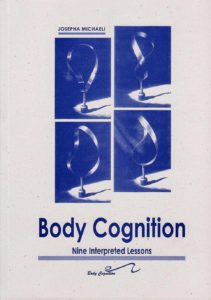About the book:
 The series of exercises included in the present book constitutes a representative sample only, taken from a wide variety of options
The series of exercises included in the present book constitutes a representative sample only, taken from a wide variety of options
embodied in the movement way of working advocated by ‘Body Cognition’. In the format presented here – their duration and complexity – the lessons are designed for experienced and thorough students as well as for professionals in the field of physical education. The special way by which the lessons are structured offers professionals the opportunity of creating numerous and different lessons as well as adjusting them to every level of students. The lessons emphasize the development of the students’ comprehension, fitness and bodily awareness, while referring to their individual capabilities and needs. That is why the lessons engage with the students’ body and their individual space. Nevertheless, understanding the principles of the ‘Body Cognition’ method makes it possible to use the lessons, while upholding their nature, as a starting point for movement in general space and as an infrastructure for every kind of physical activity at all ages: dancing, sport, working with or without various aids, integrated group activity or individual practice as well as in our day-by-day life.
The lessons according to the ‘Body Cognition’ method seem relaxed, calm, lacking ‘actual’ physical efforts and, apparently, are not in line with fostering the students’ fitness, strengthening their muscles and improving their flexibility in the accepted and customary way. However, experiencing and persevering with the lessons attest that the ‘loss’ – resulting from the calculated renouncement of achieving, at all costs, certain harmful movements, dictated pace and ‘sweating’ – is beneficial to the accomplishment of all the required physical goals, namely strengthening, improving and fostering in an elegant and sophisticated way. Another important aspect is the degree of interest and inquisitiveness that the lessons evoke in the students. The way the lessons are built, layer upon layer, in a logical and planned way, stimulates students to comprehend not only merely the specific movement performed at that movement but also its relation to the previous or next movement.
Integration of thinking in the movement does not necessarily mean limitation of spontaneity and creativity in the work
or of the pleasure derived from the moving body. These features are manifested by improvisations on the various topics and are attained in the best way only after internalizing those topics, both physically and cognitively. Such internalization is achieved through quiet work, high concentration. Attention to the bodily activity motivates students to improve the ways of expressing themselves, enrich the variety of their movements and gain fine-tuning and intricacy of self-expression, while maintaining the quality and beauty of the movement. This unique combination of work, yielding pleasurable and lovely-to-look-at movements, is accomplished only by understanding the internal relations between thought and movement. Thus, every session turns into an experience, whereby the body thinks the movements of its parts.
Table of Content:
Prologe ……………………………………………………… 1
Preface ………………………………….…………………. 3
Fundamental Assumptions of the Method …….…. 7
Lesson Plan ……………………..………………….….… 14
Positions of Control and Rest ……….…………..….. 19
Using the Book Effectively ……..…………………… 30
List of Terms ……………………………….……..….… 32
Nine Interpreted Lessons ……..…………….…….… 39
1. Vertebral Rotations (‘Wringing movement’) .… 41
2. Arm Rotations …………………………………..…… 63
3. The Chest as a Link Between
the Pelvis and the Head …………………………..…. 87
4. Breathing …………………………………………….. 111
5. The Relation Between Straightening the
Hip Joints and Flattening the Lumbar ………..…. 135
6. The Wall as an Exercising Aid …………….……. 155
7. Neck and Torso …………………………..…….…. 181
8. Overall Activation of the Body with
an Emphasis on the Legs Work ………..……….… 207
9. Back and Hip Joint Rotations ………..…..……. 233
Epilogue ………………………………..…………..….. 255
Bibliography ……………………………….………….. 257
Price: 112 NIS ..
